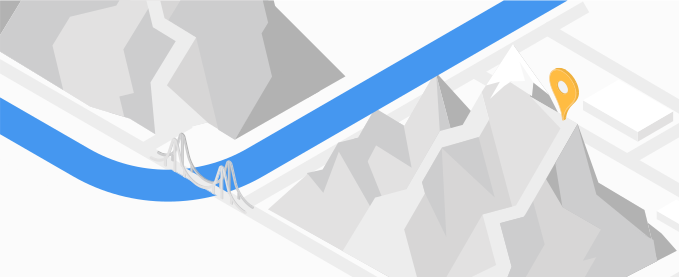
Elevation API は、Google による調査で 地球上の場所、パスに沿ってサンプリングされた高度データなどです。
Elevation API を使用する理由
Elevation API を使用すると、 高度に敏感なアクティビティ、ポジショニング アプリケーション、低測量のお客様に利用 ルートに沿った高度および高度の変化を含むアプリケーションを開発できます。たとえば 標高差のデータを提供して、スポーツ アプリケーションの機能を強化して、 ハイキング、サイクリング、スキューバダイビングなど、
Elevation API でできること
Elevation API を使用すると、高度データを 使用できます。例:
- 特定の場所の高度を取得する。
- ルート沿いまたは 2 つの地点の標高の差を計算する あります。
Elevation API の仕組み
Elevation API は、緯度と経度の座標を含むエンコードされた URL としてリクエストを受け入れます。 個別の場所として指定することも、経路上の一連の場所として指定することもできます。このリクエスト たとえば、コロラド州デンバーの中心部の高度をクエリし、JSON 形式で戻り値を指定します。https://maps.googleapis.com/maps/api/elevation/json ?locations=39.7391536%2C-104.9847034 &key=YOUR_API_KEY
このサービスでは、指定された座標の高度が取得されます。また、 各地点の標高に基づいて、各地点の 4 つの地点の平均 高度データを提供している最寄りの場所はありませんそして最後に、 決定します。
リソース
次の表に、 Elevation API で返されるデータを表示します。
| データリソース | 返されるデータ | 戻り値の形式 |
|---|---|---|
| 緯度と経度の座標
データは、1 つ以上の場所のセットとして、または経路上の一連のデータとして指定できます。マイページ エンコードされた座標も指定できます。最大 512 個の座標を渡します。 |
Elevation API は、相対値メートル単位の高度を提供します。 ローカル平均海面(LMSL)に換算します。高度は正の値で返すことができます または負の値になります。
|
|
Elevation API の使用方法
| 1 | 設定する。 | まずは Google Cloud プロジェクト 設定を完了します。 説明します。 |
| 2 | 高度リクエストを試す | API キーを取得したら、 ダウンロードします。リクエストの例をご覧ください。 をご覧ください。 |
| 3 | より複雑なリクエストを作成する | プロジェクトを設定したら、住所とともに位置情報を提供するリクエストをお試しください。 あります。パスの指定をご覧ください。 をご覧ください。 |
| 4 | 回答の基本を理解する | 高度データのレスポンスを確認して、アプリで高度データを使用する準備をします。詳しくは、 高度リクエストのレスポンス をご覧ください。 |
| 5 | 高度データを独自のアプリに組み込む | 高度データを使用して、スポーツ用のアプリなど、位置情報を利用したアプリの機能を強化できます 使用したりできます |
利用可能なクライアント ライブラリ
この API を 次のいずれかのクライアント ライブラリを使用できます。
- Java Google マップサービスのクライアント
- Python Google マップサービスのクライアント
- Go クライアント (Google マップサービス)
- Node.js Google マップサービスのクライアント
Google マップ用の Java クライアント、Python クライアント、Go クライアント、Node.js クライアント サービスはコミュニティでサポートされているクライアント ライブラリで、 Apache 2.0 ライセンス。 GitHub からダウンロードしてください。GitHub には、インストール手順やサンプルコードも用意されています。
次のステップ
- Elevation API の使用を開始する: Google Cloud プロジェクトで使用できます。
- パスベースの標高データを取得してみましょう: パスの指定
- ベスト プラクティスに従う: ウェブサービス ベスト プラクティスをご覧ください。

